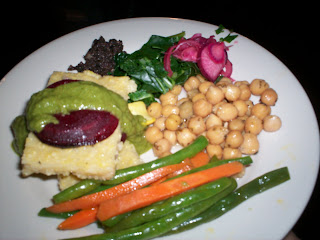Miso Soup with Daikon, Bok Choy, Wakame and Shiitake Mushrooms

Sautéed Broccoli with Greens, Pressure Cooked Brown Rice with Gomashio, Adzuki Squash Kombu and
Nishime style Turnips, Cabbage, Carrot and Sqush, (clockwise from left)
 Warren Kramer
Warren Kramer is an internationally recognized macrobiotic counselor, educator and cooking instructor. For the past 19 years, he has studied and lived the macrobiotic way of life. Warren teaches the macrobiotic approach to health and wellness, including principles of food selection and preparation, exercise, work and personal relationships. He recently joined us at the Natural Epicurean Academy of Culinary Arts for an intensive workshop.
Warren Kramer's weekend workshop, Planning your Personal Path to Health kicked off with a lecture Friday evening titled, Optimum Health without Cooking a Thing, then lead into two days study, lecture, cooking demonstrations, visual diagnosis and group consultations. Each participant recieved a health consultation and created an action plan for acheiving their personal health goals. This is the second time we've hosted this weekend. It has proven to be an invaluable experience.
The weekend included breakfast, lunch and dinner on Saturday and Sunday. For dinner, we ate the dishes Warren demonstated in the cooking class. He prepared 10 dishes total, showcasing the 10 Most Important Dishes for Creating Health. A few of the dishes are pictured below.
Carrot and Burdock Kinpira
Sautéed Broccoli with Greens
Blached Salad of Bok Choy, Daikon, and Red Cabbage
Eating condiments and natural, salt-fermented pickles with your grain is essential for proper digestion, and mineral assimilation. One of the most delicious, simple, and universal condiments is gomashio. Gomashio literally means sesame (goma) salt (shio), and while it only contains those two ingredients, it does have multiple steps, but they are worth it. It is important to use high quality sea salt for this condiment. Gomashio can be used on grains, greens, and beans.
Gomashio
Yields: 12 servings
1/3 cup organic sesame seeds
1 teaspoon unrefined sea salt, SI brand recommended
Rinse and strain sesame seeds. If you have time, allow the seeds in the strainer to drain for about 30 minutes. Put the strainer on a folded towel to help absorb water from the seeds.
Heat a skillet and roast the salt until dry and loose. Heating the salt will release chlorine gas and turn the salt slightly gray. Place the roasted salt in a suribachi and grind into a very fine powder.
Unless you have left the seeds to dry overnight, you will need to dry them completely before continuing with the recipe. To do this, heat a stainless steel or le Creuset frying pan (not cast iron) over medium heat. Place the seeds in the skillet and dry roast them, stirring continuously with a wooden spoon for even roasting. Roast the seeds until they no longer stick to the spoon.
When the seeds begin to pop, test them by crushing a few seeds between your thumb and a finger. If they crush easily, the seeds are ready. If the seeds begin to smoke, the heat is too high and you should quickly remove the pan from the heat and lower the flame. Pour the finished seeds in the suribachi. Roast the remaining seeds one layer at a time. After roasting all the seeds, grind them in the suribachi with the sea salt. Continue grinding until about 70-80% of the seeds are ground. (It takes only a light touch to crush the roasted seeds).
Serve a sprinkling on grains as a condiment. Gomasio stored in an airtight jar will retain maximum freshness for about two weeks.
Variations:
Add more sesame seeds for a milder gomashio.



































 Notes:
Notes:









